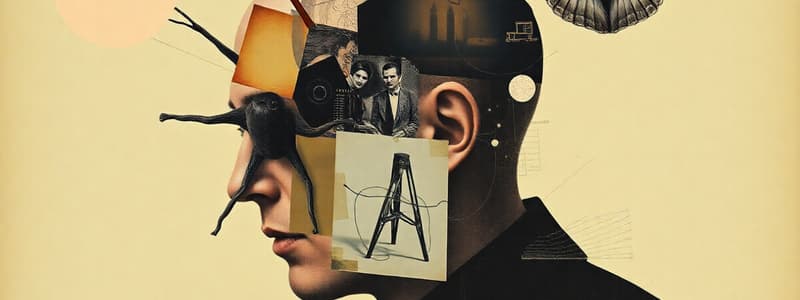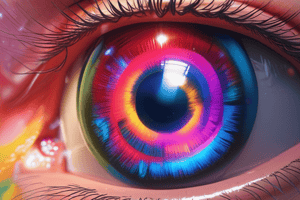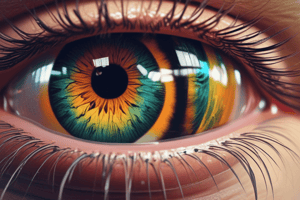Podcast
Questions and Answers
What structure relays auditory signals to the primary auditory cortex?
What structure relays auditory signals to the primary auditory cortex?
- Cerebellum
- Temporal Lobe
- Auditory Nerve
- Thalamus (correct)
Higher frequencies of sound waves are perceived as lower pitch.
Higher frequencies of sound waves are perceived as lower pitch.
False (B)
What are the basic tastes recognized by the human tongue?
What are the basic tastes recognized by the human tongue?
Sweet, Salty, Sour, Bitter, Umami
Taste receptor cells detect specific chemicals in food and trigger a series of biochemical reactions leading to the generation of __________.
Taste receptor cells detect specific chemicals in food and trigger a series of biochemical reactions leading to the generation of __________.
Match the cranial nerves with their corresponding function in taste perception:
Match the cranial nerves with their corresponding function in taste perception:
Which of the following best describes umami?
Which of the following best describes umami?
The sense of taste operates independently of the sense of smell.
The sense of taste operates independently of the sense of smell.
In addition to the tongue, where else can taste buds be found?
In addition to the tongue, where else can taste buds be found?
What type of cells in the retina are responsible for color vision?
What type of cells in the retina are responsible for color vision?
Rods are primarily responsible for color vision in well-lit conditions.
Rods are primarily responsible for color vision in well-lit conditions.
What structure in the ear amplifies sound vibrations?
What structure in the ear amplifies sound vibrations?
What is the primary function of the vestibular sense?
What is the primary function of the vestibular sense?
The visible part of the ear that helps funnel sound waves is called the ______.
The visible part of the ear that helps funnel sound waves is called the ______.
Match the following parts of the ear with their functions:
Match the following parts of the ear with their functions:
The semicircular canals are responsible for detecting linear movements.
The semicircular canals are responsible for detecting linear movements.
What serves a protective function by alerting an individual to potential harm?
What serves a protective function by alerting an individual to potential harm?
What is the main role of the optic nerve?
What is the main role of the optic nerve?
The ability to perceive and distinguish between hot and cold stimuli is called __________.
The ability to perceive and distinguish between hot and cold stimuli is called __________.
The optic chiasm allows for the integration of visual information from both eyes.
The optic chiasm allows for the integration of visual information from both eyes.
The three small bones in the middle ear that amplify sound vibrations are called ______.
The three small bones in the middle ear that amplify sound vibrations are called ______.
Match the following components of the vestibular system with their functions:
Match the following components of the vestibular system with their functions:
Which part of the inner ear helps detect gravity?
Which part of the inner ear helps detect gravity?
Which type of receptor is responsible for detecting deep pressure and vibration?
Which type of receptor is responsible for detecting deep pressure and vibration?
Cold receptors respond to increases in temperature.
Cold receptors respond to increases in temperature.
How does the vestibular system send signals to the brain about movement?
How does the vestibular system send signals to the brain about movement?
Nociceptors are responsible for detecting changes in temperature.
Nociceptors are responsible for detecting changes in temperature.
What is the term for the ability to discriminate between different stimuli such as textures and shapes?
What is the term for the ability to discriminate between different stimuli such as textures and shapes?
The specialized receptors in muscles, tendons, and joints that provide information about body position are called __________.
The specialized receptors in muscles, tendons, and joints that provide information about body position are called __________.
Which of the following is NOT a function of sensory receptors in the touch system?
Which of the following is NOT a function of sensory receptors in the touch system?
Match the type of mechanoreceptor to its function:
Match the type of mechanoreceptor to its function:
Touching something sends electrical signals to the brain via __________.
Touching something sends electrical signals to the brain via __________.
What contributes to our sense of body awareness and coordination?
What contributes to our sense of body awareness and coordination?
What is the primary role of the olfactory epithelium?
What is the primary role of the olfactory epithelium?
Olfaction only plays a role in the perception of flavors.
Olfaction only plays a role in the perception of flavors.
What happens during taste adaptation?
What happens during taste adaptation?
Odor molecules are also known as ______.
Odor molecules are also known as ______.
Match the component of the olfactory system with its description:
Match the component of the olfactory system with its description:
Which structure sends signals to the primary olfactory cortex?
Which structure sends signals to the primary olfactory cortex?
Humans can discriminate between a limited number of different odors.
Humans can discriminate between a limited number of different odors.
The olfactory receptors initiate a ______ signal when an odorant binds to them.
The olfactory receptors initiate a ______ signal when an odorant binds to them.
Flashcards
Rods
Rods
Specialized cells in the retina responsible for vision in low light conditions. Contribute to peripheral vision.
Cones
Cones
Specialized cells in the retina responsible for color vision and detail in well-lit conditions.
Cornea
Cornea
The clear outer layer of the eye that helps focus light.
Pupil
Pupil
The opening in the iris that controls the amount of light entering the eye.
Signup and view all the flashcards
Lens
Lens
The part of the eye responsible for focusing light onto the retina.
Signup and view all the flashcards
Retina
Retina
The layer of tissue at the back of the eye that contains photoreceptor cells (rods and cones).
Signup and view all the flashcards
Optic Nerve
Optic Nerve
The nerve that transmits electrical signals from the eye to the brain for processing.
Signup and view all the flashcards
Optic Chiasm
Optic Chiasm
The point where some fibers from each optic nerve cross over, allowing information from both eyes to be integrated by the brain.
Signup and view all the flashcards
Olfaction
Olfaction
Sensory system responsible for detecting and interpreting odors in the environment.
Signup and view all the flashcards
Olfactory Epithelium
Olfactory Epithelium
The part of your nose where odor molecules are detected.
Signup and view all the flashcards
Olfactory Receptor Neurons
Olfactory Receptor Neurons
Cells in the olfactory epithelium that have receptors for specific odor molecules.
Signup and view all the flashcards
Odor Molecules
Odor Molecules
Airborne chemicals that stimulate olfactory receptors.
Signup and view all the flashcards
Transmission of Signals
Transmission of Signals
The process of olfactory receptor neurons sending signals to the brain.
Signup and view all the flashcards
Olfactory Bulb
Olfactory Bulb
The part of the brain that processes basic odor information.
Signup and view all the flashcards
Odor Recognition and Discrimination
Odor Recognition and Discrimination
The ability to recognize and distinguish between different odors.
Signup and view all the flashcards
Olfactory Adaptation
Olfactory Adaptation
The process of becoming less sensitive to a particular odor over time.
Signup and view all the flashcards
Auditory Nerve
Auditory Nerve
The auditory nerve carries electrical signals from the ear to the brain, allowing us to understand and interpret sounds.
Signup and view all the flashcards
Thalamus (Auditory)
Thalamus (Auditory)
The thalamus, a central processing hub in the brain, receives auditory signals and relays them to the auditory cortex.
Signup and view all the flashcards
Primary Auditory Cortex
Primary Auditory Cortex
The primary auditory cortex, located in the temporal lobe, processes and interprets sound information.
Signup and view all the flashcards
Pitch
Pitch
The frequency of sound waves determines pitch. Higher frequencies correspond to higher pitches.
Signup and view all the flashcards
Loudness
Loudness
The amplitude of sound waves determines loudness. Greater amplitude means louder sound.
Signup and view all the flashcards
Taste Buds
Taste Buds
Taste buds are small structures located on the tongue, roof of the mouth, and back of the throat, containing taste receptor cells.
Signup and view all the flashcards
Taste Receptor Cells
Taste Receptor Cells
Taste receptor cells in taste buds detect specific chemicals in food, triggering a series of biochemical reactions that generate neural signals.
Signup and view all the flashcards
Cranial Nerves (Taste)
Cranial Nerves (Taste)
The facial and glossopharyngeal nerves carry taste information from the tongue to the brain for processing.
Signup and view all the flashcards
Tactile discrimination
Tactile discrimination
The ability to discern variations in touch sensations, including textures, shapes, and temperatures.
Signup and view all the flashcards
Mechanoreceptors
Mechanoreceptors
Specialized sensory receptors that respond to mechanical pressure or deformation, providing information about touch, pressure, and vibration.
Signup and view all the flashcards
Proprioceptors
Proprioceptors
Receptors in muscles, tendons, and joints that provide information about body position and movement.
Signup and view all the flashcards
Body awareness
Body awareness
The awareness of your body's position and movement in space, influenced by proprioception.
Signup and view all the flashcards
Somatosensory system
Somatosensory system
A complex sensory system that allows individuals to perceive and interact with the physical world through various types of touch, pressure, temperature, and pain.
Signup and view all the flashcards
Thermoreceptors
Thermoreceptors
Receptors in your skin that are specialized for detecting changes in temperature.
Signup and view all the flashcards
Nociceptors
Nociceptors
Receptors that detect pain and potential tissue damage.
Signup and view all the flashcards
Fine touch
Fine touch
Areas of the body with high tactile sensitivity, such as fingertips and lips, allowing for precise discrimination of texture and shape.
Signup and view all the flashcards
Thermal Discrimination
Thermal Discrimination
The ability to distinguish between hot and cold stimuli.
Signup and view all the flashcards
Pain Perception
Pain Perception
The subjective experience of pain, involving interpretation and processing of nociceptive signals by the brain.
Signup and view all the flashcards
Vestibular Sense
Vestibular Sense
The sense responsible for balance and body orientation in space.
Signup and view all the flashcards
Semicircular Canals
Semicircular Canals
Three loop-shaped tubes in the inner ear filled with fluid. They detect rotational movements.
Signup and view all the flashcards
Otolith Organs
Otolith Organs
Structures in the inner ear that detect linear movements and gravity.
Signup and view all the flashcards
How does the Vestibular Sense work?
How does the Vestibular Sense work?
The fluid inside the semicircular canals moves when you move your head, bending hair-like cells to send signals to the brain about your movement.
Signup and view all the flashcardsStudy Notes
Experimental Psychology PSY 2103
- Course information includes the date (12/12/2024) and course name: Experimental Psychology PSY 2103.
Senses - Vision
-
Photoreceptors: Specialized cells in the retina (rods and cones). Rods are sensitive to low light, while cones are responsible for color vision and details in well-lit conditions.
-
Process of Vision:
- Light Entering the Eye: Light enters through the cornea, aqueous humor, pupil, and lens, focusing on the retina.
- Retina: Photoreceptors convert light energy to electrical signals.
- Optic Nerve: Transmits these signals to the brain for processing.
Visual Pathways
-
Optic Chiasm: Some fibers from each eye cross to the opposite side of the brain, allowing integration of both eyes' information.
-
Color Vision: Cones in the retina are responsible for color vision (red, green, and blue).
Ear
-
Audition: The sense of hearing. The ear detects and interprets sound waves.
-
Outer Ear:
- Pinna: Collects and funnels sound waves.
- Ear Canal: Carries sound waves to the eardrum.
-
Middle Ear:
- Eardrum (Tympanic Membrane): Vibrates when struck by sound waves, amplifying them.
- Ossicles (Malleus, Incus, Stapes): Transmit and amplify vibrations from the eardrum to the inner ear.
-
Inner Ear:
- Cochlea: A spiral-shaped, fluid-filled structure containing hair cells that convert vibrations into electrical signals.
- Vestibular System: Adjacent to the cochlea, contributing to balance and spatial orientation.
-
Auditory Nerve: Transmits auditory signals from hair cells to the brain.
-
Auditory Processing:
- signals are relayed to the thalamus.
- Information is sent to the primary auditory cortex in the temporal lobe for processing and interpretation.
- Pitch is determined by frequency.
- Loudness is determined by amplitude.
Taste
-
Gustation: The sense of taste. Specialized sensory receptors on the tongue and other parts of the mouth detect different flavors.
-
Taste Buds: Small structures found on papillae of the tongue, the roof of the mouth, and the back of the throat.
- Each taste bud consists of specialized cells, including taste receptor cells.
-
Basic Tastes:
- Sweet (sugars/carbohydrates)
- Salty (sodium)
- Sour (acids)
- Bitter (alkaline substances/harmful compounds)
- Umami (amino acids, particularly glutamate)
Smell
-
Olfaction: The sense of smell. The olfactory epithelium in the nasal cavity has specialized olfactory receptor neurons, detecting odor molecules.
-
Detection of Odors: Odorants (airborne chemicals) bind to receptors on olfactory receptor neurons, initiating a neural signal.
-
Processing:
- Olfactory bulbs send signals to the olfactory cortex.
- Information is processed in the limbic system, affecting emotions and memories.
-
Signal Transmission: Neural signals are generated and travel through the olfactory nerve to the olfactory bulb.
Touch
-
Somatosensation: The sense of touch. Specialized sensory receptors in the skin detect pressure, temperature, and pain.
-
Sensory Receptors:
- Mechanoreceptors (respond to pressure/deformation):
- Pacinian corpuscles (deep pressure/vibration).
- Thermoreceptors (detect temp).
- Nociceptors (detect pain).
- Mechanoreceptors (respond to pressure/deformation):
-
Key Receptors:
- Meissner's corpuscles (detect light touch/texture changes).
- Merkel cells/discs(detect pressure/texture).
- Ruffini endings (detect skin stretch/sustained pressure).
-
Proprioception: Specialized receptors in muscles, tendons, and joints provide information about body position & movement.
-
Temperature Sensation: Thermoreceptors detect temperature changes.
-
Pain Perception: Nociceptors detect noxious stimuli causing pain.
Vestibular Sense
- Balance and Spatial Orientation: The vestibular sense allows for balance and understanding body movement in space.
- Components:
- Semicircular canals (detect rotational movements).
- Otolith organs (detect linear movements/gravity).
- How it Works: Fluid movement in the inner ear stimulates hair-like cells, sending signals about movements to the brain for processing.
- Importance: Essential for balance, coordination, and spatial orientation. Problems can cause dizziness and motion sickness.
Studying That Suits You
Use AI to generate personalized quizzes and flashcards to suit your learning preferences.




